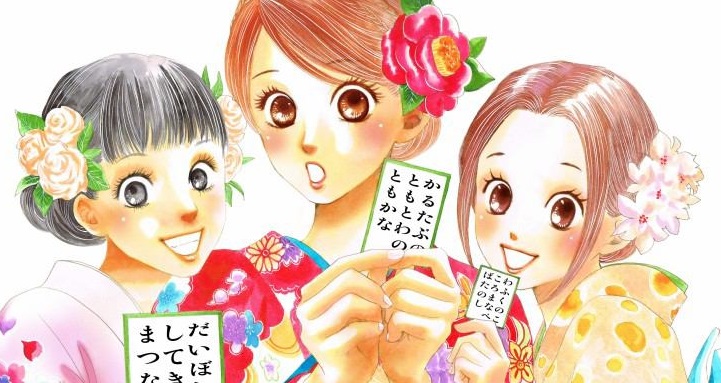|
Information  Hi dear, thanks for visiting the Chihayafuru Fanclub! ちはやふる ファンクラブ、ようこそ。٩(^ᴗ^)۶ෆ⃛
Feel free to join us, this is a place where everyone who likes Chihayafuru can join and have fun together. Happy welcome!
Even when you're new to the franchise, that's no problem! We are looking forward to old and new friends to join our Karuta club.
You can find here more information to get a good idea of the series and many related topics, but be aware of possible spoilers.
Hi dear, thanks for visiting the Chihayafuru Fanclub! ちはやふる ファンクラブ、ようこそ。٩(^ᴗ^)۶ෆ⃛
Feel free to join us, this is a place where everyone who likes Chihayafuru can join and have fun together. Happy welcome!
Even when you're new to the franchise, that's no problem! We are looking forward to old and new friends to join our Karuta club.
You can find here more information to get a good idea of the series and many related topics, but be aware of possible spoilers.
 Chihayafuru is the anime adaptation of the manga with the same name written and illustrated by Yuki Suetsugu and serialized in the magazine Be Love. Chihayafuru won the second Manga Taisho award in 2009 and the 35th Kodansha Manga Award in the shoujo manga category in 2011. Kodansha published the first three volumes of Chihayafuru, consisting of the first seventeen chapters, in two English/Japanese volumes under their Kodansha Bilingual Comics line, on December 21, 2011 and February 23, 2012 respectively. Then Animax Asia released the anime with English subtitles in 2013. The second season of the anime adaptation aired from January 12, 2013 to April 29, 2013. Later the OVA was added, titled Chihayafuru 2: Waga Mi Yo ni Furu Nagame Seshi Ma ni, on September 13, 2013.
The Chihayafuru: Chuugakusei-hen Novels (Chihayafuru: Middle School Arc) have been serialized between Sep 13, 2012 to Dec 13, 2013 in 4 Volumes and have been illustrated by Suetsugu, Yuki and written by Tokiumi, Yui.
Two live-action films were released in 2016. The first, titled Chihayafuru Kaminoku (The First Line), opened in Japanese cinemas on March 19, followed by a second film, titled Shimonoku (The Second Line), on April 29, 2016.
Chihayafuru has become so popular that it boosted interest in competitive karuta. The manga has sold over 4.5 million copies and has been praised for combining elements of sports and literature.
Kodansha Comics USA has been digitally publishing the series in English since February 14, 2017.
On October 13, 2017 the Spinoff Manga Chihayafuru Chūgakusei-hen (Chihayafuru Middle School Arc) started to be published - written by Tokiumi, Yui and drawn by Oto Tōda. The manga adapts Yui Tokiumi's spinoff novel series for Yuki Suetsugu's Chihayafuru manga.
During a stage greeting event for the second live action film, a surprise announcement was made that a sequel would be produced, the third live action film with the title Musubi (The End), which is currently in it's production and is announced to be released in 2018. In February, 2018 it was also announced that the Chihayafuru live action movies will get a five-episode tie-in series on Hulu Japan on February 20, 2018. The series is titled Chihayafuru -Tsunagu- (Chihayafuru: Connect), and it will connect the story of the second film with the third and upcoming film. It will also include behind-the-scenes footage and cast interviews. In addition, the film will get another tie-in titled Chihayafuru -Manabi- (Chihayafuru: Study) on Hulu Japan on the same day. Chihayafuru -Manabi- will introduce the new members of the Mizusawa Karuta Club and explain the rules of karuta.
During a voice actor stage presentation at the Chihayafuru in Awara Week in early 2018, it was announced that Yuki Suetsugu's Chihayafuru manga is getting a third television anime season. The anime will premiere in 2019 on NTV's late-night AnichU programming block and on other channels. ٩(^ᴗ^)۶
Plus, the spin-off/sequel manga Chihayafuru Plus: Kimi ga Tame started releasing in December 2023.
(Source: Chihayafuru Manga, Anime Site and ANN article about the Hulu series and the third anime season announcement.
announcement of spin-off/sequel manga)
Chihayafuru is the anime adaptation of the manga with the same name written and illustrated by Yuki Suetsugu and serialized in the magazine Be Love. Chihayafuru won the second Manga Taisho award in 2009 and the 35th Kodansha Manga Award in the shoujo manga category in 2011. Kodansha published the first three volumes of Chihayafuru, consisting of the first seventeen chapters, in two English/Japanese volumes under their Kodansha Bilingual Comics line, on December 21, 2011 and February 23, 2012 respectively. Then Animax Asia released the anime with English subtitles in 2013. The second season of the anime adaptation aired from January 12, 2013 to April 29, 2013. Later the OVA was added, titled Chihayafuru 2: Waga Mi Yo ni Furu Nagame Seshi Ma ni, on September 13, 2013.
The Chihayafuru: Chuugakusei-hen Novels (Chihayafuru: Middle School Arc) have been serialized between Sep 13, 2012 to Dec 13, 2013 in 4 Volumes and have been illustrated by Suetsugu, Yuki and written by Tokiumi, Yui.
Two live-action films were released in 2016. The first, titled Chihayafuru Kaminoku (The First Line), opened in Japanese cinemas on March 19, followed by a second film, titled Shimonoku (The Second Line), on April 29, 2016.
Chihayafuru has become so popular that it boosted interest in competitive karuta. The manga has sold over 4.5 million copies and has been praised for combining elements of sports and literature.
Kodansha Comics USA has been digitally publishing the series in English since February 14, 2017.
On October 13, 2017 the Spinoff Manga Chihayafuru Chūgakusei-hen (Chihayafuru Middle School Arc) started to be published - written by Tokiumi, Yui and drawn by Oto Tōda. The manga adapts Yui Tokiumi's spinoff novel series for Yuki Suetsugu's Chihayafuru manga.
During a stage greeting event for the second live action film, a surprise announcement was made that a sequel would be produced, the third live action film with the title Musubi (The End), which is currently in it's production and is announced to be released in 2018. In February, 2018 it was also announced that the Chihayafuru live action movies will get a five-episode tie-in series on Hulu Japan on February 20, 2018. The series is titled Chihayafuru -Tsunagu- (Chihayafuru: Connect), and it will connect the story of the second film with the third and upcoming film. It will also include behind-the-scenes footage and cast interviews. In addition, the film will get another tie-in titled Chihayafuru -Manabi- (Chihayafuru: Study) on Hulu Japan on the same day. Chihayafuru -Manabi- will introduce the new members of the Mizusawa Karuta Club and explain the rules of karuta.
During a voice actor stage presentation at the Chihayafuru in Awara Week in early 2018, it was announced that Yuki Suetsugu's Chihayafuru manga is getting a third television anime season. The anime will premiere in 2019 on NTV's late-night AnichU programming block and on other channels. ٩(^ᴗ^)۶
Plus, the spin-off/sequel manga Chihayafuru Plus: Kimi ga Tame started releasing in December 2023.
(Source: Chihayafuru Manga, Anime Site and ANN article about the Hulu series and the third anime season announcement.
announcement of spin-off/sequel manga)
Chihaya Ayase is a girl who has spent most of her life simply supporting her sister in her model career. That changes when she meets a boy named Arata Wataya, a talented karuta player who recognizes the potential Chihaya has to become a great player. As Chihaya takes on a new dream of becoming Japan's best karuta player, she is soon separated from her karuta playing friends, Taichi Mashima and Arata Wataya, as they grow up. Now in high school, Chihaya still continues to play karuta in the hope that she will one day meet her friends again. (Source: http://chihayafuru.wikia.com/wiki/Chihayafuru) Chihayafuru is set in Japan in the west suburban area of Tokyo, estimated Fuchū City. Furthermore, other prefectures are also included and take part in the story, which are Fukui, Shiga, Ishikawa, Shizuoka and Kyoto. East Ōsato Elementary School Mizusawa High School Katamichi Culture Hall (Training base of Shiranami Karuta Society) Bubaigawara Station Ōe Traditional Clothing Shop Bunkyō City Otsuka Karuta Memorial Hall Katsugi Bookstore Fujioka East High School Omi Jingu Shrine Omi Jingu Learning Center Shirayama Hime Shrine Fujisaki Highschool Fukuoka (Training base of Fujisaki Highschool) Kyoto Station Kiyomizu Temple Kinkaku-ji / Rokuon-ji Nin'na-ji Temple Arashiyama Palace of the Hundred Poets(Shigureden Theme Park) Yoshino Karuta Society The Ogura Hundred Poets was completed during the Kamakura period. Fujiwara no Teika compiled them by taking one poem each from 100 of the best poets in chronological order from Emperor Tenji to the Retired Emperor Juntoku to decorate the sliding doors at the Ogura mountain villa, the summer home of the general and poet Utsunomiya Yoritsuna. Many of selected poems were ornamental in nature, because they were meant to be used as decoration. Seventy-nine male poets! Twenty-one female poets! I am particulary attracted to the works of female poets! You can feel the seasons and modesty in way that can't be found in modern poetry! - Kanade Ōe You can find the full list of the cards on the following sites: http://www.karuta.org/data/image.html?num=100 (Japanese with images of the Karuta cards) & http://jti.lib.virginia.edu/japanese/hyakunin/frames/hyakuframes.html (Japanese, Romaji and English without images) (Source: http://chihayafuru.wikia.com/wiki/Ogura_Hyakunin_Isshu) Hyakunin Isshu Karuta is a Japanese card game. Hyakunin Isshu (百人一首) is a traditional anthology style of compiling Japanese waka poetry where each contributor writes one poem for the anthology. Literally, it translates to "one hundred people, one poem each". It also refers to the card game of uta-garuta, which uses a deck composed of poems from one such anthology. Karuta Karuta (歌留多) is a type of card game. The name is a loaned word from the Portuguese word Carta, meaning "Card", which was imported into Japan in the 16th century. The Western playing card evolved into two types of games in Japan: card-matching game Karuta and poker-like Hanafuda. One of the variants of the former is Ogura Hyakunin Isshu Uta-Garuta. In 1904, Tokyo Karuta Association formed the official ruleset of Competitive Karuta from this Ogura uta-garuta. The group was promoted to All Japan Karuta Association in 1954, when they formed Rank system and started the national Karuta Master competition and Queen competition at Oumi Jingu Shrine.  Chihayafuru Volume 3 - Chapter 13
Chihayafuru Volume 3 - Chapter 13
Competitive karuta is played between two players, with a card reader (who reads out the card poems) and a judge to assist. The objective is for the players to clear the cards on their territory before their opponent. The game uses two types of cards: Yomifuda: One hundred reading cards with a figure of a person, their name and complete tanka poem on each one Torifuda: One hundred playing cards with only the lower phrases of their corresponding tanka Each player chooses 25 random torifuda cards and arranges them face up in three rows on their territory. Their territory is 87 cm wide, and is 3 cm away from the opponent's territory. The players have 15 minutes to memorize the positions of the cards. Once the time ends, the reader recites the opening poem ("Naniwa-zu ni/Sakuya kono hana/Fuyu-gomori/Ima wo haru-be to/Sakuya kono hana") to let the players familiarize themselves with the reader's voice. After the opening poem, the reader then reads out one of the 100 yomifuda cards.The first player who touches the torifuda card with the correct second verse takes the card. 50 of these yomifuda have their corresponding torifuda in the players' territories. The remaining yomifuda are dead cards. If a player takes the card from their opponent's territory, that player can send one of their cards to their opponent Ji-jin (Player's Territory) Formation of cards layed at player's own side. Jijin cards are easier to win for shorter distance. Players usually separate them into right and left for ease of flicking. Teki-jin (Opposite Territory) Formation of cards layed at opposite side. Tekijin cards are harder to win for longer distance and reversed letters. Kara-fuda (Void Cards) Dead Cards. Only 50 cards are used in a game, and remaining 50 cards are not in play, becoming Kara-fuda. Touching cards when a Kara-fuda is read is penalized with Otetsuki. Joka (Opening Poem) The Introductory poem which is read at the beginning of game. The poet, Naniwa Bay, is not from Hyakunin Isshu poems. Dokushu (Reader) The reciter who reads poems. Note that dokushu is not referee. Karuta is played without referees, and troubles between players should be solved by the agreement of the players themselves. Otetsuki (False Touch) Fault. To touch a wrong card. One card penalty. Okuri-fuda (Sending Cards) When a player wins a card from the opposite territory, or when the opponent gets penalized, the player sends one card from his/her own territory. The choice of Sending Card is important for constructing strategically favorable formation. Daburu or Dabu (Double Sending Cards) It happens when a player made Otetsuki at opposite territory while the opponent won a card from player's territory. Two Otetsuki in one turn is also a double penalty. A loanword from English. Seimu (Same) A loanword from English. 1. Tie. The situation of when both players have the same amount of cards. 2. The situation of when both players touch correct card at the same time. Unmei-sen (Fatal Game) The situation of Seimu (tying) with only one card remaining. Since it is almost impossible to win the opposite card in this situation, the result of the game is simply dependent on dokushu's next card; hence "Fatal". Genpei-sen (Genpei War) A karuta match that uses all one hundred cards. Unofficial team play rule. Tomo-fuda (Like Cards) Cards which begin with same syllable. The "Chi-ha-ya-fu-ru" card has two Tomo-fuda, Chi-gi-ri-ki-no- and Chi-gi-ri-o-ki-shi. Kimari-ji (Unique Syllable) The first several syllables with which players can be sure which card to take. The Unique Syllables of "Chi-ha-ya-fu-ru" is "Chi-ha-", for other Tomo-fuda cards begin with Chi-gi-. 1-ji Kimari, 2-ji Kimari....(One Syllable Card, Two Syllables Card....) The cards of one (two, three,...) unique syllable(s). The Chi-ha-ya-fu-ru card is Two Syllables Card. Chi-gi-ri-ki-no- and Chi-gi-ri-o-ki-shi are Four Syllables Cards. Ooyama-fuda (Long Shot Cards) Six Syllables Card. Players often wait with Kakoi-te, since reciter takes a pose after the fifth syllable. Kimariji-Henka (Unique-syllable Shift) The Unique Syllables change from moment to moment as the game proceeds. Chi-ha-ya-fu-ru changes from Two Syllabes Card to One Syllabe Card when Chi-gi-ri-ki-no and Chi-gi-ri-o-ki-shi leave the game. Mu-Su-Me-Fu-Sa-Ho-Se (Girls, dry the bunches!) A famous mnemonic for learning One Syllable Cards. Kakoi-te (Covering Hand) A technique to cover a card with the player's palm and fingers until the Unique Syllable is determined. The other player has to break the cover to win it. In Chihayafuru anime episode 4, Chihaya tried to break through Yasuda's cover, only to be blocked by his big palm. Watari-te (Cross Hand) Player is not penalized with Otetsuki when he/she flicks two directions under a certain condition. Yusei took a measure to contain Chihaya's Cross Hand tactic in episode 8. Modori-te (Back Hand) A technique to pull player's hand back away from opposite territory to flick their own territory. In some cases, aiming a card with Modori-te is faster than aiming the card directly. Tsuki (Thrust) A technique to attack opponent's guarded inner low area. Seme-karuta (Offensive Karuta) The play style of focusing on opposite territory. Technical features are, for example, 1. Aim Cross Hand to opposing Like Cards. 2. Send Like Cards of shorter Unique Syllables for aiming Back Hand. 3. Aim at right-handler's weak point, opponent's lower right area, for first. etc. Mamori-karuta (Defensive Karuta) The play style of focusing on player's own territory. Technical features are, for example, 1. Sprit Like Cards to prevent opponent's Cross Hand. 2. Send Like Cards of Three Syllable Cards to lure opponent's faults. 3. Aim at own lower right area for first, etc. Club Members Club Pictures
Displaying 5 of 11 topics | See All Club Discussion
Club Comments
|
 Club Stats
Members: 459
Pictures: 13
Category: Anime
Created: Oct 24, 2011
Club Staff
Enin (President) Flueckli (Secretary) yui_iwisawa (Secretary) Club Type This is a public club.Anyone can join and invite others to join. Club details, pictures, comments and club discussions can be viewed by any user, regardless of whether they are a member of the club or not. Club Secretary can change the Club Type at any time. For more information on Club Types, click here. Anime Relations Manga Relations Character Relations
|
Chihayafuru Fanclub
 Club Stats
Members: 459
Pictures: 13
Category: Anime
Created: Oct 24, 2011
Club Staff
Enin (President) Flueckli (Secretary) yui_iwisawa (Secretary) Club Type This is a public club.Anyone can join and invite others to join. Club details, pictures, comments and club discussions can be viewed by any user, regardless of whether they are a member of the club or not. Club Secretary can change the Club Type at any time. For more information on Club Types, click here. Anime Relations Manga Relations Character Relations
|






